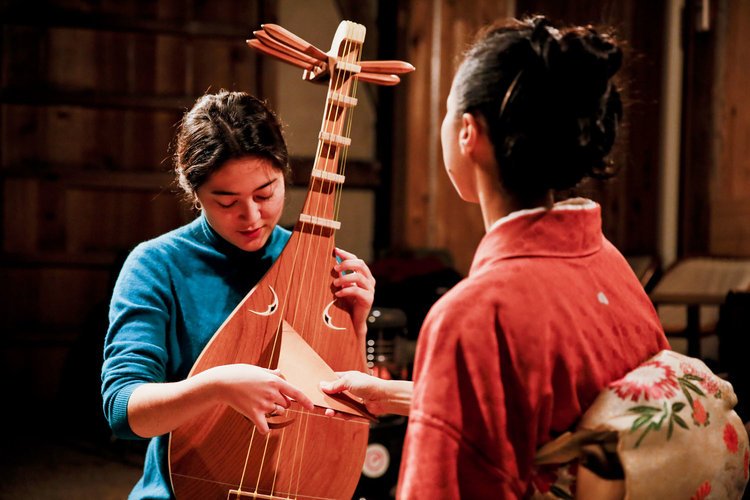Nobuko, Biwa Lute Master
By Genie Harrison
Nobuko-san first started playing the biwa lute around twenty years ago. Despite the popularity of other traditional Japanese instruments, such as the shamisen or the koto, she found herself drawn to the biwa. “The biwa is not just an instrument that produces sound,” she explains to me on a snowy Tokyo afternoon in Nezu, “the biwa has a soul.” As we speak, the deep and intimate connection between the musician and her instrument becomes apparent.
The biwa evolved from the Chinese bent-neck "pipa" which first gained popularity during China's Tang Dynasty (618-907) before spreading throughout East Asia, ultimately reaching Japan during the Nara period (710-759). Visually, the instrument bears resemblance to a lute: it has a rounded, oval body, with a short neck bearing four or five strings of twisted silk, each stretched over deep frets. Unlike the pipa, it is usually played with a large plectrum called a bachi that varies in thickness, pliability, and material. Also like a Renaissance lute, the biwa is made from entirely natural materials. “It is the instrument’s connection to the natural world,” Nobuko explains, “which provides us our own entrance.” The biwa provides a portal to a world ordinarily inaccessible.
As a young woman, Nobuko found herself attracted to the world of performing arts, acting and singing in musicals, and practicing ballet. While she enjoyed doing so, she remembers catching herself in the mirror one day during ballet class and feeling resolutely that there was something discordant about the sight. “I saw myself as Japanese,” she recalls, “so I wanted to do something that was distinctly Japanese.” Centuries old, the role that the biwa has long-played in the Japanese tradition has not only facilitated Nobuko’s embracing of her heritage, but moreover has allowed her to contribute to the next chapter of the instrument’s story in the contemporary day.
Originally used in Japan by monks as part of Buddhist practice, the biwa is often a musical accompaniment for liturgy and stories, a practice referred to as katarimono ongaku. One of its most famous uses has been for the recitation of The Tale of Heike, an epic narrative depicting the struggle for control of Japan between the Taira and Minamoto clans at the end of the 12th century in the Genpei War. “The biwa can make lots of different sounds,” Nobuko explains enthusiastically, looking over at the instrument with a fondness. “This can be very useful for telling stories. In the case of Heike, for example, the instrument’s sonic versatility allows it to invoke the spirits of the warriors, calling back those who died in battle long ago.”
Due to its connection with spiritual practice, the biwa was traditionally under the purview of men. The satsuma-biwa, which Nobuko plays, originates from Kagoshima and was used as an educational tool by samurai to teach moral lessons and bravery to younger generations. Following the instrument’s heyday in the Meiji era (1868-1912), however, there was a decline in biwa playing exacerbated by the rise in popularity of Western instruments.
Today, there are far more women playing the biwa than men, and it is people like Nobuko who are initiating its revival. After graduating from Toho Gakuen Junior College of Arts, Nobuko began studying the satsuma-biwa under Kakujoh Iwasa, master of Tsuruta-ryu style satsuma-biwa.
Incredibly animated in her disposition, Nobuko sits astride her instrument, never too far removed, with her arm resting intimately on the biwa’s neck. “The instrument has its own living presence,” she describes, “I constantly feel as though I am trying to catch up with it.” Most commonly played as a solo instrument, the biwa allows Nobuko an independence while performing to use her own voice. Through her passion for the craft and its storied tradition in Japan, the symbiotic relationship between musician and instrument is undeniable.
Now a master herself, Nobuko divides her time between giving lessons, maintaining the condition of her instrument, rehearsing her craft, and of course, performing. What Nobuko articulates, though, is her difficulty separating herself from the biwa, which has become almost an extension of herself. “I’ll pass by a building,” she says, “and wonder what it would sound like to perform the biwa there.” Even as we sit within the walls of the warm, traditional tatami room, the expanse of the world Nobuko finds herself connected to by way of the biwa is palpable.
We discuss a composition entitled November Steps, by Toru Takemitsu, a piece originally commissioned for the 125th anniversary of the New York Philharmonic. Written for both the biwa and the shakuhachi, the composition spotlights these two traditional Japanese instruments alongside a Western orchestra in a soaring, cinematic epic, and was met with great acclaim by critics and composers alike. Showcasing the biwa’s capabilities, the commission is a prime example of the instrument’s growing prominence in the world of classical music. Nodding enthusiastically when I mention it, Nobuko refers to November Steps as “the product of a genius,” lamenting that she never got the opportunity to hear it performed live – particularly as Takemitsu had been her own teacher’s teacher.
Although interest in the instrument has picked up over the last century, in part due to the internet, Nobuko acknowledges that the biwa remains an unpopular choice for young people: “If children do show an interest, they can attend lessons at school and begin attuning themselves to the practice of traditional instruments from a young age.” Introducing other people to the biwa and watching them enjoy the experience is one of the elements of her career of which she is most proud. “Even though more people have heard of the biwa,” she explains, “I still surprise people from time to time with the sounds that it makes.”
I ask Nobuko about how her relationship with the instrument has changed over the course of her twenty-year career, which she considers momentarily. “When I first started playing,” she explains, “I was obsessed with being able to play as my teacher did and improvised as quickly as I could.” “Now though,” she continues, “I am able to feel the meaning of the instrument.” This is something she finds particularly important and something she wishes to pass on to the next generation of biwa players.
“This is not a Western instrument,” Nobuko says firmly. “It is important to let the biwa do what it can do.” This distinction is significant: it is engaging with and embracing the instrument as inherently Japanese that has enabled Nobuko to connect with her own identity. She continues: “Even though it is limited in the number of notes you are able to produce, this requires a greater sense of sincerity when playing, and a commitment to making the sound more meaningful.” She trails off, confessing that this is an aspect of her craft that she finds difficult to articulate clearly.
However, when Nobuko performs a brief excerpt from The Tale of Heike, this sense of sincerity is easily discernible. The biwa’s distinctive and powerful sound fills the tatami room, its resonance dovetailing her own surprisingly low, rich voice. There is an entrancing quality to her performance that recalls the instrument’s spiritual tradition, as if to transport us back to a time long forgotten. Even to an untrained ear, a moment with the master and her instrument provides us a brief glimpse into the biwa’s ineffable soul.
Read more about Nobuko’s biwa lute workshop and experience here.
About the Author: A recipient of the Daiwa Anglo-Japanese Scholarship, Genie Harrison is a writer currently based in Tokyo, where she works for popular lifestyle magazine, Tokyo Weekender. Educated at the University of Cambridge, she specializes in literature, with a particular focus on contemporary fiction written by Japanese female authors.








